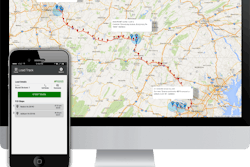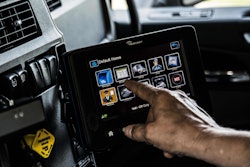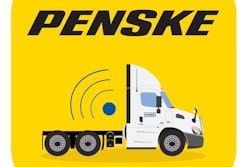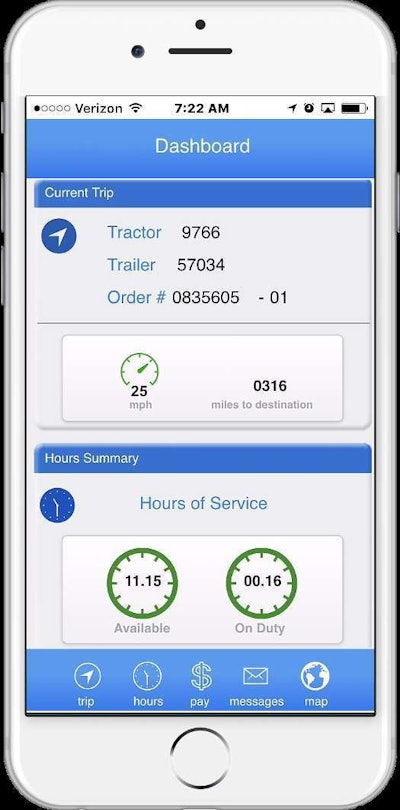 IES Mobile from TMW Systems gives drivers visibility to information in the enterprise, including hours-of-service duty status.
IES Mobile from TMW Systems gives drivers visibility to information in the enterprise, including hours-of-service duty status.Keeping drivers connected has become an important strategy for motor carriers. By deploying mobile apps, companies are simplifying work for drivers, and thereby removing inefficiencies and frustration points in the workday and from the work lifestyle of trucking.
In part one of this series, we looked at enterprise apps that can give drivers a single sign-on experience from personal mobile devices. We continue with mobile driver apps and web portals that compliment fleets’ existing in-cab mobile platforms.
ProBuild, one of the nation’s largest suppliers of lumber and building materials, has 360 locations in 40 states with a delivery fleet of 2,400 vehicles. One of the reasons the company chose the Telogis platform is the flexibility to use any device to run electronic logs, driver vehicle inspection reporting (DVIR) telematics, navigation, route optimization and more.
ProBuild is using iPhones and other Apple iOS devices for the driver display.
“We had a blue collar workforce,” said Tom Gustafson, IT director for the Denver-based company. “Whatever we picked we knew it better be easy to use, as that’s the only way we are going to get it out to the field.”
The Apple iOS platform is not just the easiest for drivers to use; it fits the company’s long-term vision for mobility, he said.
“Telogis will not be the only application on our devices.”
Extending the range of mobility
Sometime later this year, Omnitracs plans to release a Mobile App suite that motor carrier customers can offer to drivers to extend certain functions of in-cab IVG and MCP platforms, also from Omnitracs.
One of the first new products will be an hours-of-service (HOS) app that will allow drivers to change duty status from on duty to off duty, for example, and to view their logs, says Laura Lohrke, senior product manager.
Among the first additions to the suite will be new mobile versions of Omnitracs’ vehicle inspection reporting and messaging, she says. The company plans to create new apps that can work independently from in-cab platforms and allow drivers to keep certain data and functions as they change carriers. For example, drivers may want to keep their previous 8 days of electronic log data when they change jobs, she says.
PeopleNet recently updated its companion mobile app, ConnectedDriver, with a new user interface. The app already had messaging and hours-of-service duty status and daily summary information. These features have been relocated in the app to make them easier to use. The ConnectedDriver app lets drivers see up to two weeks (14 days) of detailed HOS data.
Going mobile with TMS
Companies that develop enterprise software systems for transportation management (TMS) have traditionally not competed with products from Omnitracs, PeopleNet and other telematics providers. That could soon change.
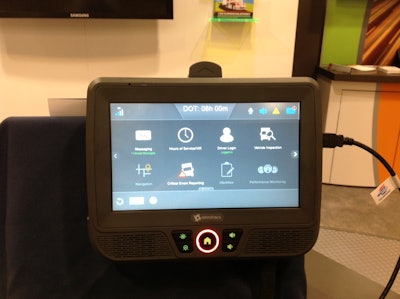 Omnitracs plans to release a suite of mobile apps to compliment features in its in-cab platforms
Omnitracs plans to release a suite of mobile apps to compliment features in its in-cab platformsTMW Systems and PeopleNet are both owned by Trimble. TMW Systems does not have a mobile driver app that would compete with PeopleNet, but TMW customers that use the Innovative IES transportation management system have a new option to keep drivers connected outside the cab.
IES Mobile Driver is a web interface, not an app, that drivers can access from their Android or iOS devices to review and manage trip details and messages, as well as monitor Hours of Service (HOS), view current routes and examine paycheck information.
McLeod Software currently offers a privately branded mobile driver app that its carrier clients can use to give their drivers access to certain functions in the LoadMaster TMS system such as messaging and payroll settlements.
McLeod is considering a deeper partnership with Geotab, a telematics provider, to include additional features in its mobile app.
“There are a lot of things we can do, but we are going to do common sense things. The technology is there and we are going to take advantage of it because if not we know someone else will,” says Mack Killough, vice president of software development at McLeod Software.
Freight tracking without assets
Non-asset transportation companies are also using mobile apps to stay connected with owner-operators and small carrier drivers to track shipments.
Choptank Transport, one of the largest third-party logistics providers, is using the Load Track platform from Trucker Tools. Load Track is embedded in the Trucker Tools driver smartphone app to capture real-time shipment locations using the GPS on drivers’ phones.
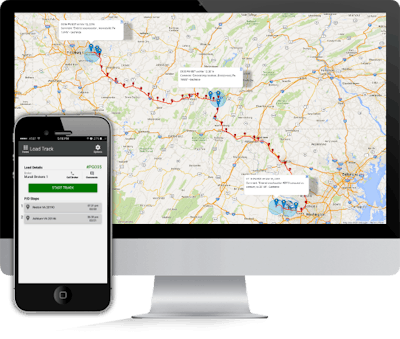 Choptank Transport uses the Load Track platform from Trucker Tools to have shipment visibility.
Choptank Transport uses the Load Track platform from Trucker Tools to have shipment visibility.The tracking process begins when a driver is dispatched to pick up a load and continues, uninterrupted, to the final delivery.
“We don’t want to track drivers,” explains Paul Wood, Director of Carrier Services, “we want to track our customer’s freight. That is an important distinction to make.”
Choptank Transport uses the information to proactively ensure on-time customer service and eliminate manual “check calls” to carriers and drivers, says Adam Wheatley, director of logistics for Preston, Md.-based Choptank.
The company uses custom forms in the Load Track feature of the app to prompt drivers to capture shipment data for case counts, trailer seal numbers and trailer temperatures. Drivers can also instantly message dispatchers with exceptions or concerns about the shipment and capture images of proof-of-delivery documents.
“The ability to communicate with drivers through the app has been very nice,” Wheatley says. “For example, we have had drivers send us pictures of the loading or unloading facilities to let us know they are backed up at the gate and what time they expect to depart.”
The free Trucker Tools app has been downloaded by more than 420,000 drivers, who use the app’s trip planning features to locate truck stops, truck washes, weigh scales and fuel prices along routes as well as truck-specific navigation.
The vast majority of truck drivers own smartphones, and are willing to use that technology to stay connected in ways make their workday easier. This presents new opportunities for asset and non-asset transportation companies to deploy mobile apps and reap mutual benefits with drivers.



